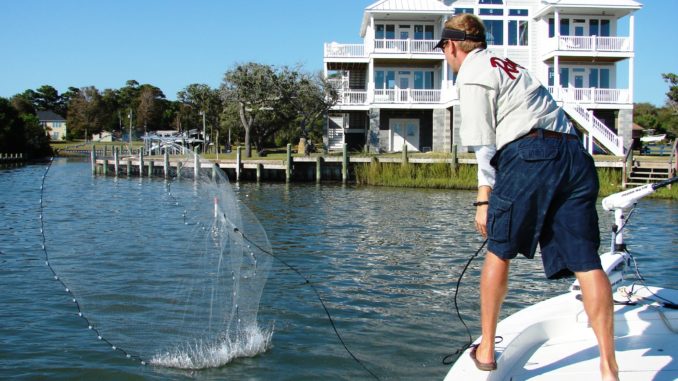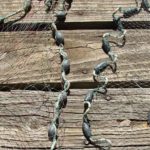
Understand size, mesh, weights for best use
I don’t know that there is any single piece of fishing equipment that is less understood than a cast net. What? That’s easy. They are nets thrown to catch bait. While that is absolutely correct, unfortunately it isn’t quite that simple. During boat and fishing shows, I always get a bunch of questions on cast nets, which brought about this column.
Cast nets are manufactured by numerous companies, and not all cast nets are created with equal quality. I won’t go into this beyond design, but the first thing to understand is there are significant differences in design. There are different purposes, too. This primer on cast nets should help folks pick the one that will suit them best for their needs. Learning to throw a cast net is another thing altogether and is a topic for a separate story.
While some cast nets are used to catch fish for food, the purpose here will be for catching bait. They are probably the most-popular method across the entire spectrum and this includes shrimp, minnows, mullet, menhaden and more. Unfortunately, there isn’t one cast net that catches everything well.
Two difference between nets that most people understand are size and weight. Most manufacturers size their nets using the measurement from the horn — the plastic or metal eye in the middle where the take up lines pull through — to the lead line. The net will open to twice this measurement; a 4-foot net, for example, opens to 8 feet. Weight is simply the amount of weight added to the lead line to make the net sink, and it is usually measured in pounds per foot. A light net might be 1 pound per foot, and a heavy net might be 1 1/2 pounds per foot.
It seems pretty reasonable that a larger net will cover more water and should catch more bait. That is generally true, but there are a few exceptions.
The biggest mistake with cast nets is assuming that simply adding weight will make a net sink faster and therefore, catch more bait. It would be great if it were only that simple, but it doesn’t work in actuality. The added weight will make the net sink faster, but unless the net is constructed to work with the additional weight, it will pull closed while sinking and not catch anything more than a few feet deep.
This brings us to the measurement of mesh size in a net. The mesh is the size of the hole in the weave. In very simple terms, the larger the mesh, the less resistance the net has moving through the water and the faster it will sink with a given amount of weight.
Most manufacturers measure the mesh with the hole open and square. Betts Tackle, a Fuquay-Varina company that is a leader in cast nets, manufactures several lines of cast nets with mesh sizes as small as 1/4-inch and as large as 1 inch. Mesh size is as important as the net size and weight. Larger mesh sizes sink faster but won’t catch smaller baits. If you are after small minnows and shrimp, you need a smaller mesh. However, if the bait is holding deep, it’s not as simple as adding weight to get to it quicker.
The generalities on mesh size is that catching small baits requires 1/4- or 3/8-inch mesh cast nets. The 1/4-inch mesh will catch mud minnows, silversides, other small fish and small shrimp, while the 3/8-inch mesh works well on larger minnows, larger shrimp, corn cob-size mullet and peanut menhaden. Some companies weight their 1/4-inch mesh nets a little heavy to make them sink quickly the first 6 feet or so. They will begin closing when sinking deeper than that. For baits holding a little deeper, 3/8-inch mesh nets don’t have as much weight but will stay open better while sinking.
Nets in 1/2-inch mesh are for baits that are a little larger and generally work better in shallow water. Some fishermen like to use them to catch menhaden for king mackerel fishing so they don’t gill any small menhaden. Unfortunately, they don’t sink quickly, and in deep water, the bait can swim out from under them. Just like with the smaller mesh net, adding weight pulls them together and closes them in deeper water.
Many 5/8- and 3/4-inch mesh nets were designed to catch menhaden and larger baits. The 3/4-inch mesh sinks faster with equal weight and can handle being a little heavier to sink even faster. The 5/8-inch mesh is sometimes used as a compromise between 1/2- and 3/4-inch mesh nets. It will gill a few more smaller fish than 1/2-inch mesh, but not as many as 3/4-inch mesh, and it will sink faster than the 1/2-inch mesh, but not as quickly as 3/4-inch mesh.
Fishermen looking to catch larger baits, but who don’t feel they can throw the heavy nets designed to catch menhaden, should look at nets with 1-inch mesh. Most of these are designed to catch mullet and are constructed with less weight, but they still sink pretty quickly because the mesh is so large. They aren’t the answer for everyone, but some fishermen really like them.
Relatively new on the scene, at least in North Carolina, are cast nets called “deep hole” nets. These nets came about in the cast-net shrimp fishery in South Carolina and with a few fishermen catching shad for striper baits in the deep water at the base of dams. “Deep hole” nets have a band or strip around the bottom, just above the lead line, to help hold them open as they sink.
The first “deep hole” net I saw was homemade. It had a 2-inch strip of vinyl lawn furniture webbing sewn all the way around it about 3 inches above the lead line. I asked why and was told it caught water and prevented the net from closing while sinking in deep water. Another homemade “deep hole” net used the good HVAC tape (not duct tape) in the same position, with strips inside and out and the net webbing sandwiched between them. These strips slow the sinking of the net, which is why some “deep hole” nets are made heavier, but they do a surprisingly good job of holding the net open as it sinks through deeper water.
Cast nets are made two basic ways, and the type of construction affects both the performance and the price. Basic nets are made using horizontal seams, with sections sewn on top of each other to make the desired size. Any extra netting is gathered at the top of the net. They are simple to make and are less expensive, but the extra netting can make them difficult to throw and sink slower.
Premium cast-net construction uses vertical seams to join pie-shaped wedges of net. This doesn’t have excess netting at the top of the net, which makes them easier to throw and sink faster. This technique requires six seams instead of one, which makes them more expensive, but many fishermen feel the performance is worth the extra cost.
Cast nets are available clear and with color. Clear or white nets are the standard. Betts offers nets in blue, green, chartreuse and a red-and-green combination they call No Spook. Some fishermen prefer the blue and green colors, as they feel they blend better with the water where they are catching bait and are less visible sinking through the water. Betts said the chartreuse net is made bright to help get kids interested in cast nets.
No Spook nets aren’t chosen as much for their colors but because the color process removes their shine, and they don’t reflect as highly to warn fish they are being thrown. No Spook coloring is available in several sizes of 3/8- and 1/2-inch mesh nets for small bait and in the 3/4-inch mesh extra heavy menhaden net. Many king mackerel fishermen believe they have an edge using the No Spook net when menhaden are being chased hard and are skittish.
Hopefully, this answers most of the questions you might have about cast nets. As with anything, there are a few exceptions to the rules, but this is a quick explanation of the basics.






Be the first to comment